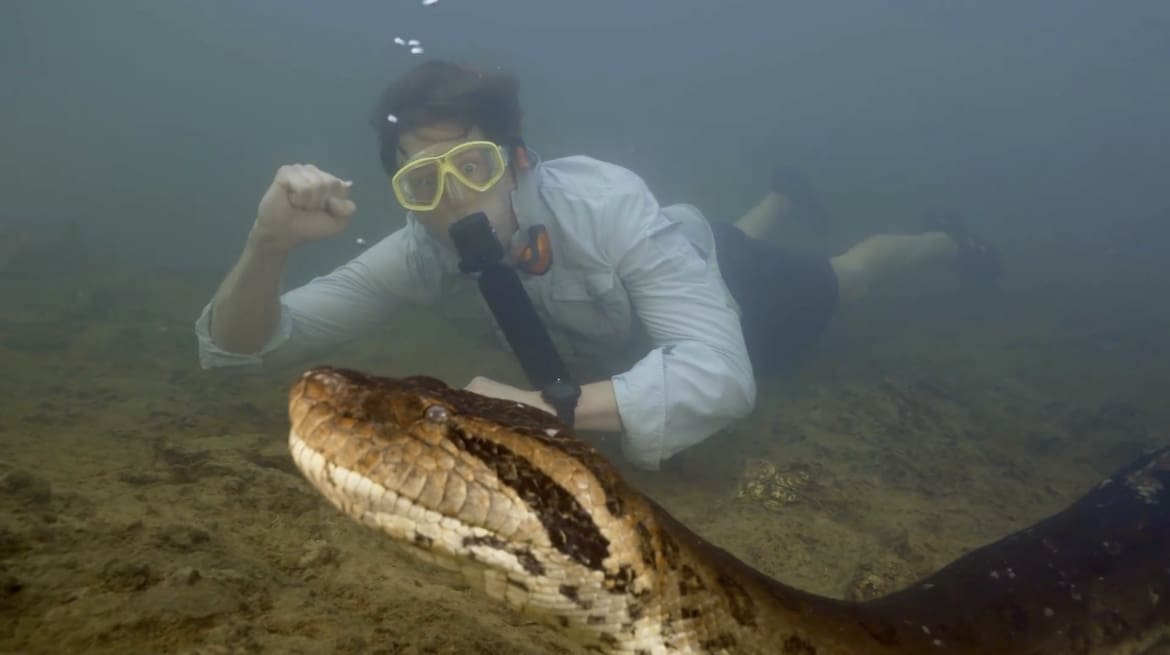In an extraordinary expedition that reads like the plot of an adventure film, a groundbreaking discovery has been made in the heart of the Amazon. A new, gargantuan species of snake has been unveiled, The Northern Green Anaconda – marking a significant milestone in the field of herpetology and challenging our perceptions of the natural world.
An Unlikely Ally: The Will Smith Documentary
This remarkable narrative takes an even more thrilling turn with the involvement of a documentary film crew led by none other than Will Smith. During the filming of the National Geographic documentary “Pole to Pole with Will Smith,” Professor Bryan Fry of the University of Queensland and his team, in collaboration with the Indigenous Waorani people, stumbled upon what is believed to be the largest snake ever recorded.
The discovery of a 26ft-long anaconda with a “human-sized” head not only underscores the Amazon’s capacity to hide giants but also highlights the ongoing threats to its biodiversity. The exploration, initially aimed at assessing the environmental impacts of oil drilling, revealed a stark reminder of the delicate balance between development and conservation.
This serendipitous encounter not only highlights the Amazon’s hidden giants but also underscores the ongoing threats to its biodiversity. The exploration, initially aimed at assessing the effects of oil extraction on local wildlife, revealed a stark reminder of the delicate balance between development and conservation.
Collaboration with the Waorani People
A harrowing incident involving a Waorani man, who was nearly dragged into the water by this massive anaconda, underscores the dangers faced by those living in and exploring this remote wilderness.
The encounter, marked by the anaconda’s unusually large bite marks, suggested an individual approximately 7.5 meters (24.6 feet) in length, dwarfing previously captured specimens.
Further insights gained during the expedition revealed a startling disparity in toxin levels between male and female anacondas, with males exhibiting 1000 percent higher concentrations of lead and cadmium.
This finding, while alarming, offers a unique lens through which to assess the environmental health of the Amazon and the creatures that inhabit it.
Dutch professor of Biology Freek Vonk swimming with a huge specimen of the newly discovered species
Unveiling the Northern Green Anaconda
The distinction between the green anacondas of Ecuador and their Brazilian counterparts led to an important scientific classification: the designation of the newly discovered snakes as the northern green anaconda, spanning territories in Ecuador, Colombia, and Venezuela, in contrast to the smaller southern green anaconda.
With a DNA difference of about 5.5 percent, this differentiation not only enriches our understanding of biodiversity but also emphasizes the intricate evolutionary paths of Amazonian wildlife. Professor Fry’s comparison of this genetic variance to the relatively minor difference between humans and chimpanzees provides a compelling perspective on the significance of this discovery.
Described by Fry as the “biggest of his career,” the discovery of the northern green anaconda challenges our perceptions of the natural world and highlights the endless mysteries awaiting in the Amazon. Fry’s humorous speculation about describing a xenomorph, as a nod to the unexpected nature of scientific exploration, adds a touch of levity to the profound implications of their findings.
This expanded narrative serves as a beacon for the importance of scientific inquiry, the value of indigenous knowledge, and the urgent need for conservation efforts to protect the Amazon’s unparalleled biodiversity. As we marvel at the revelations brought forth by this adventurous collaboration, the story of the northern green anaconda stands as a testament to the wonder, danger, and scientific potential that the Amazon continues to hold.

